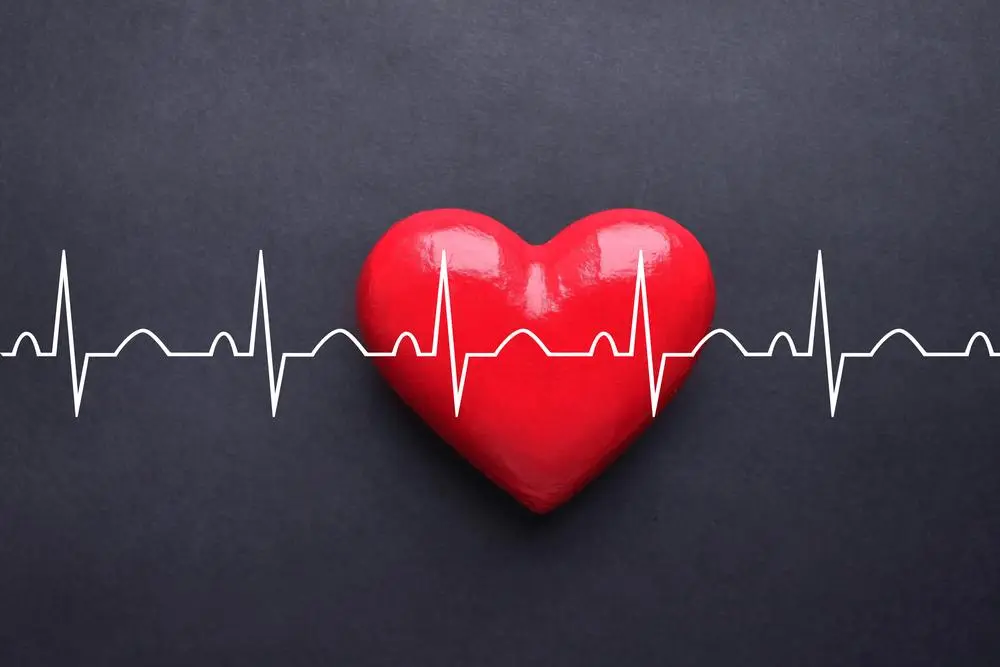Contents
Atrial fibrillation (AF) is a heartbeat disorder in which there is a malfunction in the electrical conduction system of the upper parts of the heart – the atria. An electrical impulse circulating along a modified route causes individual muscle fibers of the atria to beat uncoordinatedly and much faster than normal, giving the impression that they are trembling or “flickering.” This phenomenon is called “fibrillation”. Since all parts of the heart work in close connection with each other, atrial fibrillation causes the lower chambers of the heart (ventricles) to beat out of sync.
Normally, the atria and ventricles work together so the heart pumps blood at a constant rhythm, but the irregular functioning of the heart’s conduction system in atrial fibrillation can cause a fast, fluttering heart rate—100 to 175 or even 200 beats per minute—instead of the normal 60 to 90.
Is MA (FP) dangerous?
When the heart contracts in AFib, blood does not flow smoothly from the atria to the ventricles and moves poorly throughout the body. Atrial fibrillation can be dangerous and increases the risk of stroke and heart failure.
What are the symptoms of AF:
The main symptom of atrial fibrillation (AF) is an abnormal, most often rapid, heart rhythm. But for many people, the symptoms of AF are not obvious. They may not be pronounced or feel like something normal. You should always pay attention if you experience:
- uneven pulse
- heart palpitations
- feeling like the heart is moving or fluttering in the chest
- chest pain
- feeling of lack of air, shortness of breath;
- slight dizziness or faintness, weakness;
- sweating without exercise
If you notice the above symptoms, You should definitely consult a therapist or cardiologist.

What forms of atrial fibrillation (atrial fibrillation) are there?
Atrial fibrillation can have a variable duration and go away on its own, without the use of drugs or physical methods (cardioversion). If an episode of MA lasts several minutes-hours-days, no more than 2 days and goes away on its own, then this type of MA is called paroxysmal. With repeated attacks (paroxysms) of atrial fibrillation, they speak of a recurrent form.
The persistent form lasts up to 7 days and often requires medical intervention to restore normal rhythm. The permanent form of AF, as the name suggests, lasts indefinitely, and the normal rhythm cannot be restored, or it is restored for a short time and is again replaced by ineffective atrial contractions. Most often, when an episode of AF occurs for the first time, it is paroxysmal in nature; over time, the episodes become more and more prolonged and the rhythm becomes more and more difficult to restore until atrial fibrillation becomes permanent.
MA is also divided into groups depending on the frequency of ventricular contractions. Highlight
- tachysystolic form, from the word “fast”, “accelerated” – in this form the frequency of contraction of the ventricles of the heart exceeds the normal rhythm of 90 beats per minute;
- bradysystolic form – heart rate less than 60 per minute;
- and normosystolic form, in which the heart beats at a speed of 60-90 beats per minute, but the rhythm of contractions is irregular
Why does MA (AF) develop?
The causes of AF development are divided into cardiac and non-cardiac.
As the name suggests, with the cardiac nature of MA, the root cause lies in the existing pathology of the cardiovascular system. Once suffered inflammatory processes in the myocardium, for example, unnoticed myocarditis caused by a viral infection, coronary heart disease, developmental defects and cardiopathy, hypertension leading to enlargement of the heart muscle – all this can provoke the development of MA.
Noncardiac causes are any conditions or diseases that can alter the functioning of the conduction system of the heart and provoke attacks of AF. Most often, these are toxic factors such as alcohol, chronic overexertion and stress, especially fueled by excessive doses of caffeine and nicotine; electrolyte disturbances due to kidney disease, fever and dehydration; taking certain medications, thyroid diseases and much, much more.
What causes the development of MA?
Most often, atrial fibrillation develops against the background of such common diseases as:
- Arterial hypertension and other forms of high blood pressure;
- Atherosclerosis of coronary vessels and coronary heart disease;
- Heart failure;
- Congenital or acquired heart defects;
- Previous myocarditis and other diseases leading to the formation of myocardial fibrosis;;
- Chronic lung diseases, leading to the formation of a “pulmonary heart”;
- Acute severe infections causing intoxication;
- Disorders of the thyroid gland;
- Also, the likelihood of developing atrial fibrillation is caused by various exogenous intoxications associated with taking alcohol and other toxic substances, and taking certain medications, especially in combination
Who gets MA (AF)?
The chance of developing AF is higher in the following groups of patients:
- European men;
- Over the age of 60;
- Having a family history of MA;
- Smoking and overweight
Factors that provoke the development of MA are called triggers. There are controlled and uncontrolled triggers of MA (AF). Controlled triggers are:
- being overweight or obese
- drinking too much alcohol
- smoking
- use of stimulants, including some illicit drugs
- taking certain prescription drugs such as albuterol and others;
- stress, lack of sleep, especially against the background of increased doses of caffeine;
- period after heart surgery (coronary artery bypass grafting or other type of heart surgery can trigger the development of AF. Fortunately, this type of AF usually does not last long).
What can happen during an attack of MA?
The consequences of paroxysmal AF are explained by ineffective blood circulation and incomplete emptying of the atria of the heart due to their poor contraction. Ineffective blood circulation as a consequence of an attack of atrial fibrillation does not always develop; often the ventricles contract enough to maintain normal blood flow. However, if the ventricles contract too quickly or slowly or irregularly, then signs of circulatory failure develop – severe weakness, sweating, nausea, dizziness, lightheadedness and loss of consciousness. The most severe consequence of an attack of atrial fibrillation can be a state of shock, in which blood pressure drops sharply, an insufficient amount of oxygen enters the human organs and tissues, pulmonary edema, oxygen starvation of the brain, multiple organ failure and death can develop.
But even in cases where the frequency of ventricular contraction is capable of maintaining satisfactory blood circulation, and the person’s condition suffers only slightly, the danger to health remains. If the atria do not contract, but twitch, and the blood is not completely expelled from them, but instead stagnates, then after 1,5-2 days the risk of blood clots forming in the parietal sections of the atria and in the so-called ears sharply increases. This happens if you do not take special preventive measures in the form of taking medications that can reduce the risk of thrombosis. The consequence of the formation of blood clots in the atria is a sharply increased risk of thromboembolism. Thromboembolism is a serious complication in which a blood clot leaves the site of its formation and floats freely through the vessels. Depending on where it is carried by the bloodstream, and which artery is blocked by a fragment of a blood clot, one or another clinical picture will develop. Most often this is a stroke or necrosis of an arm or leg. However, any localization of the lesion is possible – myocardial infarction or intestinal infarction also occur.

How to diagnose MA (AF)?
If a patient consults a doctor in the midst of an attack of AF, then the diagnosis is not difficult; it is enough to take an ECG and the cause of the symptoms that the patient complains about becomes completely clear. However, in addition to stating the fact of atrial fibrillation, the doctor is faced with the task of understanding the causes and form of an attack of AF, which is necessary to choose the correct treatment tactics. When AF is initially detected, the doctor needs to quickly understand whether we are dealing with a permanent, persistent or paroxysmal form of the disease, what provokes its development, and whether the cause of AF development is heart disease or extracardiac factors. The correct answer to these questions is very important because the choice of treatment depends on it.
Diagnosing MA becomes difficult if the patient presents during a non-attack period and presents vague, indefinite complaints. In this case, the diagnostic method is continued ECG monitoring using Holter (Holter monitoring), which can last from 24 to 72 hours.
Continued Holter monitoring increases the likelihood of “catching” a paroxysm of AF and making a correct diagnosis. But in addition to confirming the diagnosis of MA, the doctor needs to understand the causes of the disease. Therefore, when making a diagnosis, the patient must undergo an examination designed to determine the causes and provoking factors of the disease. Such an examination, in addition to a simple medical examination and mandatory blood pressure measurement, should include instrumental and laboratory diagnostic methods. Laboratory tests include a screening panel and, in addition, determination of thyroid hormone levels, markers of systemic inflammation, iron levels, objective indicators of alcohol consumption and other toxic substances. Instrumental methods that are used at the initial stage of diagnosis are echocardiography, myocardial MRI and CT of the coronary vessels, which makes it possible to determine whether the cause of atrial fibrillation lies in the area of disease of the cardiovascular system.
When to seek immediate medical attention:
AF is not always a cause for alarm, but you should call an ambulance if:
- You feel pain in your chest;
- An uneven pulse is accompanied by a pre-fainting state and a feeling of loss of consciousness;
- Signs of a stroke appear, such as numbness in the arms or legs, difficulty moving, or slurred speech.
Increased risk of stroke in patients with MA
Let’s reiterate this important fact – people with atrial fibrillation are five times more likely to have a stroke! The reason for this is that during an attack of MA the heart does not pump blood as well as it should, and blood moving unevenly through the vessels can stagnate inside the heart, which promotes the formation of blood clots. If this happens, the blood clot can leave the site of its formation (the atrium) and travel through the bloodstream to the brain, which most likely leads to an ischemic stroke.
How long does atrial fibrillation (AF) last?
When MA(AF) first appears, it may appear and disappear. Irregular heart rhythm can last from a few seconds to several weeks. If there is a problem with the thyroid gland, pneumonia, another disease that can be treated, or toxicity that can be treated, then AF usually goes away as soon as the cause is eliminated. However, some people’s heart rhythm does not return to normal and require special treatment to restore the rhythm and/or prevent complications.
What methods are used to treat atrial fibrillation?
- When an attack of AF occurs, doctors usually try to restore the heart’s normal rhythm using medications or cardioversion. Cardioversion is a short-term effect on the conduction system of the heart with an electrical impulse in order to impose the correct rhythm of contraction. Cardioversion has contraindications – if the episode of flickering lasts 48 hours or more, then this procedure can increase the likelihood of a stroke. In order to prevent this, the doctor conducts a special study – transesophageal echocardiography to make sure that blood clots have not yet formed in the atrium. If thrombosis is suspected, the patient is prescribed blood thinning medications before restoring normal rhythm. These tablets must be taken for several weeks before and after cardioversion.
- If the symptoms of AF are not too severe, or if attacks of AF return after cardioversion, then drug therapy is usually prescribed to control the situation with drugs. Rhythm control drugs help maintain a normal heart rate and keep the heart from beating too quickly. Taking an extra daily aspirin or tablets called anticoagulants or blood thinners can help prevent blood clots and reduce the chance of stroke in people with AF.
- A minimally invasive procedure, pathologic rhythm ablation is a procedure in which a doctor inserts a small probe through a blood vessel into the heart and uses radiofrequency energy, a laser, or extreme cold to remove tissue that sends abnormal signals to the myocardium. Although this procedure does not require open heart surgery, it does carry some risks, so it is only done in patients who do not respond to cardioversion and medications.
- Installation of a pacemaker for AF (AF) is carried out in cases of particularly persistent atrial fibrillation, when the prescription of drug therapy and repeated ablation procedures do not lead to a satisfactory result, or if the result of ablation is bradycardia with a rate below 40 beats per minute or atrioventricular heart block. A pacemaker is a small, battery-powered device that sends electrical signals to set your heart rate. Typically, patients with AF are equipped with a pacemaker cardioverter with defibrillator functions or a single-chamber pacemaker with an additional ventricular electrode. To install an electrical pacemaker (pacemaker) in patients with AF (AF), an artificial atrioventricular block is created, that is, the atrioventricular node is destroyed or a complete ablation of the area of pathological impulses of AF in the atria is performed. Such patients continue to take antiarrhythmic drugs to improve the results of the operation. ECS for AF allows achieving good results in almost all patients, however, in approximately every 10 patients, a relapse of the disease is possible within a year.
How to live with atrial fibrillation?
Some patients claim that having AF does not affect their daily life. However, during a targeted survey, almost all of them complain of loss of energy, weakness, drowsiness, shortness of breath and episodes of fainting.
Atrial fibrillation can lead to a stroke or other serious problem before symptoms become apparent to the patient. To help catch an irregular heartbeat, the Stroke Association recommends checking your pulse once a month or more often with an automatic blood pressure monitor. This is especially important for patients over 40 years of age with additional risk factors for stroke. If the heart rhythm appears unstable or there are any other complaints, it is necessary see a therapist or cardiologist.
How to prevent atrial fibrillation if you are at risk?
All the same healthy habits that can protect us from any heart disease will also protect us from AF. First of all, they relate to nutrition, physical activity, stress and bad habits. So let’s repeat:
- Eat a healthy diet that includes greens, vegetables and fish;
- Have regular physical activity;
- Monitor your blood pressure;
- Don’t smoke and avoid secondhand smoke;
- Reduce or avoid alcohol;
- Check your pulse monthly;
- Regularly receive information about your health and monitor preventable diseases or their consequences (obesity, diabetes; thyroid disease etc.)

Fatigue due to atrial fibrillation
Fatigue is one of the most common symptoms of MA. Yes, this is precisely a symptom of the disease that should not be ignored. Fatigue can be caused either by the arrhythmia itself or as a result of insufficiently good blood supply to organs and tissues with the development of their hypoxia. It can also be caused by taking certain medications. Getting enough sleep, regular exercise, and a healthy diet can help combat fatigue.
Avoid factors that can trigger an attack of atrial fibrillation:
Certain things trigger attacks of atrial fibrillation. Moreover, for different patients, such triggers can be different moments and each patient, if possible, should be well aware of the features of his diagnosis and avoid these provoking factors. Some common factors that often trigger MA are listed below:
- Fatigue
- Alcohol
- Stress
- Caffeine
- Restlessness and anxiety;
- Smoking
- Viral infections;
- Taking certain medications
Nutrition and lifestyle for atrial fibrillation:
Doctors advise patients diagnosed with AF to eat a heart-healthy diet. A diet consisting of minimally processed foods, including fruits, vegetables and nuts, is recommended. Various types of fish, poultry and small amounts of cereals are also beneficial. Food should be low-fat, high in magnesium and potassium. Good sources of these electrolytes are bananas, avocados, pumpkin, melon, watermelon, oranges, potatoes, wheat bran, nuts, and beans. It is recommended to limit alcoholic drinks, rich broths, fatty meats, smoked meats, sausages, sweet and flour dishes. It is advisable to eat small meals and not eat at night, as an overfilled stomach can affect the heart rate. It is undesirable to overuse strong tea and coffee.
It is necessary to limit the amount of table salt, since too much of it increases blood pressure, and high blood pressure increases the likelihood of developing attacks of AF (AF) and even stroke. “Super-salty” foods, the high salt content of which is not obvious, include sausages, smoked meats, pizza, canned soups, and some baked goods. You should carefully check food labels before purchasing to find lower sodium options.
Before purchasing processed or instant foods, you should read the information about the content and composition and, in particular, the amount of sugar. Excess sugar in the diet also leads to increased blood pressure and, in addition, to weight gain, which can also trigger attacks of arrhythmia. Other unexpected sources of sugar: pasta sauce, granola bars and ketchup.

- Coffee
Scientific evidence regarding caffeine as a precipitant of MA (AF) is contradictory. Older studies indicate that there is such a connection, newer studies indicate that there is not. In any case, coffee consumption should be limited. Too much caffeine can increase your blood pressure and heart rate, which can trigger another attack. It is recommended to drink no more than two to three cups per day. Decaffeinated coffee is also a solution!
- Grapefruits and grapefruit juice
If you are taking medications to control your heart rate, you should either avoid this fruit and its derivatives or severely limit their consumption. In any case, before consulting a doctor. Grapefruits and grapefruit juice contain chemicals that may change the way some medications are absorbed, which may increase the likelihood of their side effects.
- Red meat
Saturated fats found in beef, lamb and pork increase the level of bad cholesterol in the blood. High levels of LDL cholesterol can lead to heart disease and coronary artery disease, and also increases the likelihood of stroke. Instead, your menu should include lean cuts of beef, as well as poultry and fish. For hamburgers, cutlets, or meatloaf, you can replace half the meat with beans to save fat.
- Butter
Whole milk dairy products, cream and cheese are also sources of saturated fat. The body produces all the bad cholesterol it needs, and eating foods with saturated fat causes it to produce even more. Best choices for your heart: skim milk and low-fat dairy products. When cooking, you should use heart-healthy oils such as olive, canola, or corn.
- fried foods
Donuts, potato chips and French fries may contain what some doctors call the worst kind of fat you can eat: trans fat. Unlike other fats, trans fats pack a double punch: they increase bad cholesterol level and reduce good cholesterol levels. Baked goods, including cookies, cakes and muffins, may also contain them. Look for the words “partially hydrogenated oil” in the ingredients.
- Energetic drinks
Many brands add extra high doses of caffeine and sugar to their products to give them an extra boost. This combination may be worse for the heart than even caffeine on its own. In one small study, energy drinks caused more changes in heart rate than other drinks with the same amount of caffeine. Another study linked energy drink consumption to attacks of AF. We should try to exclude these drinks from the diet as much as possible if a diagnosis of MA or other heart rhythm disorders is established.
- Sea salt
Of course, sea salt crystals are larger than regular salt and the flavor is slightly stronger. But sea salt contains about the same amount of sodium as table salt, contrary to what many people think. One teaspoon of any of them contains about 2 milligrams of sodium—the recommended amount per day. To break the salt habit, you should use a variety of spices and herbs to season your dishes, such as ginger for chicken or paprika for soups.
- White rice
Milled rice grains are nearly devoid of the nutrients and fiber the heart needs to stay healthy. But recent studies demonstrate an increased content of heavy metals and, in particular, lead salts, in most samples of white rice. Fiber is necessary for the body for normal digestion; it also helps normalize cholesterol levels, reduce the risk of heart disease, obesity and type 2 diabetes – conditions that provoke the unfavorable course of AF. If you’re going to eat rice, you should choose whole grain brown or wild rice. Whole grain rice is more filling and may reduce your risk of stroke.
- Frozen slices
Those same ice-cold drinks that cool you down on a hot, muggy day can also trigger an attack of VSD. While research is still in its early stages, one recently published study suggests there may be a link between drinking a cold brew, brain freeze and irregular heartbeat. If you notice fluttering after eating or drinking something cold, talk to your doctor.
- Too much of everything
Overeating even healthy foods can cause you to gain extra pounds. If you are overweight, you are more likely to develop IBS. It also makes AFib more likely to return after certain treatments, such as ablation. If you are obese (body mass index 30 or more), try to lose at least 10% of your body weight. Start with portion control: Share a dish with a friend when you dine out, or pack half a portion before you take a bite.
However, if the patient has other health problems in addition to MA, or if he is taking certain medications, such as warfarin to prevent blood clots, then he consultation with a nutritionist is required, since choosing a diet with a combination of limiting factors becomes a difficult task.
Stay hydrated
Patients who are frequently dehydrated are more likely to experience attacks of AF/VSD. The most obvious signs of dehydration are thirst and dark yellow urine. Experts recommend that patients with MA drink a daily volume of unsweetened and non-carbonated liquid of about 2 – 2,5 liters per day, of course, if they have no other health restrictions. This includes water and liquids from other drinks and food. Staying hydrated is easy. Just keep a glass of cold water handy and drink it throughout the day.
Control your stress levels!
Stress and mental disorders can worsen the symptoms of AF. Finding healthy ways to cope with stress improves arrhythmia symptoms and improves quality of life. Commonly accepted methods of dealing with stress are:
- Meditation
- Relaxation
- Yoga
- Physical exercises
- Positive outlook
Physical exercise for atrial fibrillation
Active sports with atrial fibrillation are contraindicated, but moderate physical activity is very useful. The most effective and beneficial type of physical activity for this disease is walking, especially Nordic walking, which uses ski poles to involve the muscles of the upper half of the body in the process. When starting classes, it is better to start with a leisurely and comfortable walk, avoiding shortness of breath and provoking unpleasant symptoms. Gradually the pace and distance can be increased. You can also add up and down stairs. You can also start swimming or attend groups of therapeutic exercises, yoga, and Pilates.











Nice blog
Managing chronic conditions like MA requires a balanced approach to treatment, nutrition, and daily living. For caregivers, respite care can be a vital resource—providing temporary relief while ensuring the individual continues to receive proper support and attention.